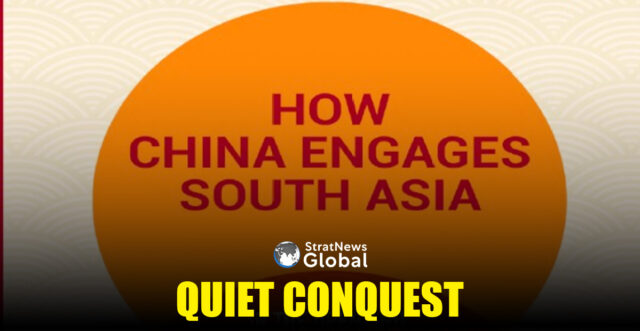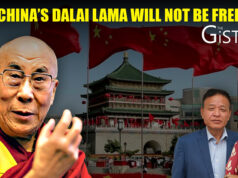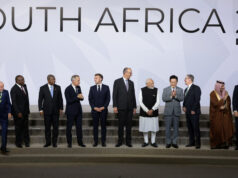Beijing’s playbook in South Asia is equal parts persuasion and penetration. A new report unveils the anatomy of influence—but stops just short of calling it what it is.
China isn’t just building infrastructure in South Asia—it’s building influence, embedding ideology, and exporting authoritarian resilience. That is the unambiguous message of ‘How China Engages South Asia: In The Open And Behind The Scenes.’
Published by the Centre for Social and Economic Progress (CSEP), this meticulously researched study surveys Beijing’s footprint from Afghanistan to Myanmar. Its core argument: The real story lies not in what China builds, but in how it quietly binds the region—through policy capture, social infiltration, and narrative control.
Yet for all its academic rigour, the report sometimes stops short of confronting the uncomfortable political truths it uncovers.
The editors rightly highlight that China is no longer just building roads—it’s building narratives, reshaping regulatory norms, and whispering in the ears of political elites.
Whether it’s party-to-party linkages in Nepal, Buddhist diplomacy in Sri Lanka, or ‘awards diplomacy’ in Pakistan, Beijing is not playing the traditional great power game. It is playing the long game. And unlike the West, which often parachutes in with aid and exits with platitudes, China embeds, adapts, and waits.
The report is an intellectual scalpel, dissecting China’s methods across five sectors: civil society and culture, economy and governance, conflict mediation, defence and security, and influence operations. Each chapter offers empirical insight into China’s multilayered strategy. But what is most striking—and troubling—is the report’s reluctance to call this out for what it is: strategic coercion through calibrated subversion.
Take China’s “awards diplomacy” in Pakistan, as explored by Eram Ashraf. This isn’t simply cultural exchange. It’s soft power weaponised, where journalists, academics and public figures are cultivated as amplifiers of Beijing’s preferred narratives. The aim, Ashraf notes, is to “generate a positive narrative of Chinese presence in Pakistan”—a country where public criticism of China is already dangerously rare, given its deep entanglement in Pakistan’s economy and politics.
In Nepal, China’s tourism diplomacy has not only rebuilt Buddhist temples but also reshaped the very identity of sacred spaces like Lumbini, the Buddha’s birthplace. As Kalyan Bhandari observes, the surge in Chinese tourists and heritage investments creates new dependencies. “The increasing visibility of Chinese actors,” he writes, “makes Nepal more susceptible to Beijing’s preferences.” In other words, heritage becomes leverage.
Hazrat Bahar’s chapter on Afghanistan shows how Chinese media is quietly filling the vacuum left by Western disengagement post-2021. With training programmes for Afghan journalists and PR campaigns embedded within newsrooms, China is not just shaping perception—it’s scripting the post-American narrative. In a country starved of international legitimacy, China’s influence has a multiplier effect: economic assistance is matched by information dominance.
The economic chapters reveal something more insidious: China’s ability to reshape domestic law. In Sri Lanka, Dilini Pathirana documents how Chinese-funded infrastructure projects have led to legal reforms that favour Chinese interests—especially in land acquisition and regulatory exemptions. These aren’t one-off accommodations; they are institutional rewrites to fit Beijing’s blueprint. “…Legal lacunae have been exposed and, in some cases, exploited,” Pathirana warns.
Anand P. Krishnan’s chapter on India’s electronics industry shows how even in a country hostile to China post-Galwan, Chinese companies like Xiaomi and Vivo continue to thrive by insulating themselves from geopolitics. Their brand strategies are hyper-local, culturally savvy, and commercially irresistible. The report notes that these firms have “adapted to the preferences of Indian smartphone consumers” to the point of being indispensable—even as Chinese apps are banned and border tensions simmer.
The most damning revelations come from the sections on defence and information operations. Rubiat Saimum’s analysis of China-Bangladesh military relations reveals a long-term plan of dual engagement: civilian diplomacy paired with arms transfers, training exchanges, and industrial cooperation. This isn’t just about selling weapons—it’s about entrenching military dependence and ensuring policy alignment.
Similarly, Ajaya Bhadra Khanal’s study of Chinese interventions in Nepal’s northern borderlands exposes para-diplomatic activity that circumvents Kathmandu entirely. From local aid to sub-national linkages with Tibet, Beijing is cultivating alternative centres of loyalty within Nepal. “The flow of aid and materials between municipalities in the northern districts and Tibetan counties… reveal the depth as well as the dangers of Chinese influence,” Khanal warns.
Devendra Kumar’s chapter on Chinese digital operations targeting the Tibetan diaspora in India and Nepal should raise alarm bells in Delhi. These are not soft power efforts—they are active measures. Using anti-Dalai Lama propaganda, surveillance, and cyber operations via the United Front Work Department (UFWD), Beijing seeks to fracture and neutralise Tibetan political identity across borders. “The cross-border movement of Tibetans is being monitored and regulated,” Kumar notes, “through coordinated digital influence and covert operations.”
Sanjana Hattotuwa’s forensic analysis of China’s social media strategy in Sri Lanka shows how disinformation is no longer outsourced—it’s institutionalised. The Chinese embassy, along with a network of proxy accounts, runs coordinated campaigns to praise China, attack critics, and amplify nationalist voices. This is not engagement. It is engineered influence with plausible deniability.
The report lauds China’s “range and creativity” and its “calibration.” But let’s call it what it really is: hybrid warfare—an ideological expansion cloaked in development. The CPC isn’t just exporting railways and 5G towers; it’s exporting its model of governance, its surveillance ethics, and its narrative control.
And while the report stops short of a moral judgment, its implications are chilling. Smaller South Asian states, eager for infrastructure and trade, often fail to see—or choose to ignore—the long-term costs. China’s offerings may seem benign, but their outcomes are far from neutral. Laws change, loyalties shift, and alternative voices are systematically drowned.
Constantino Xavier and Jabin T. Jacob, the editors of this extremely timely and relevant report, recommend a region-wide investment in China expertise, urging governments to understand how Beijing embeds itself “in the political, social, and informational fabric of the region.” That is essential. But so is recognising that these aren’t just policy tools—they are political weapons.
This report should be read as a warning. South Asia is not being lost to China through tanks or treaties, but through textbooks, training modules, and X handles.
In a career spanning three decades and counting, Ramananda (Ram to his friends) has been the foreign editor of The Telegraph, Outlook Magazine and the New Indian Express. He helped set up rediff.com’s editorial operations in San Jose and New York, helmed sify.com, and was the founder editor of India.com.
His work has featured in national and international publications like the Al Jazeera Centre for Studies, Global Times and Ashahi Shimbun. But his one constant over all these years, he says, has been the attempt to understand rising India’s place in the world.
He can rustle up a mean salad, his oil-less pepper chicken is to die for, and all it takes is some beer and rhythm and blues to rock his soul.
Talk to him about foreign and strategic affairs, media, South Asia, China, and of course India.





